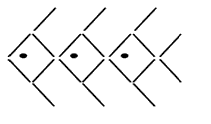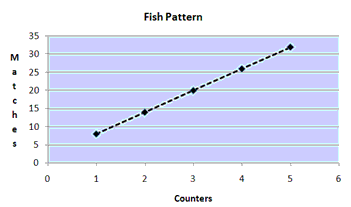Elaboration on this Achievement Objective
This means students will describe the function rule for a linear relationship as well as recognise recursive relationships where more complex relationships are involved. For example, given the pattern of fish made with matchsticks and counters below, students should be able to represent the relationships in a table and graph and use these representations to predict the terms in the sequence:
Counters | 1 | 2 | 3 | 4 | 5 |
Matchsticks | 8 | 14 | 20 | 26 | 32 |
Level Four students should be able to:
- give linear rules connecting the variables (for example, "the number of matchsticks is the six times the number of counters plus two", or "take one off the number of fish, multiply that number by six then add eight")
- extend the graph or table of a linear relationship to predict further co-ordinate pairs, recognising that constant difference (add six in the fish pattern) is associated with points that lay on a line
- use recursive methods to predict further members of a sequence where the relationship is non-linear. For example, the sequence of triangular numbers:
Number of rows | 1 | 2 | 3 | 4 | 5 | ... | 10 | Total of counters | 1 | 3 | 6 | 10 | 15 | ... | 55 |
|
| | +2 | +3 | +4 | +5 | |
Recursive means finding what is added to or subtracted from one term to get the next.


